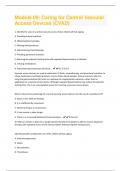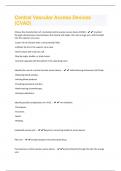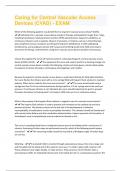Cvad - Study guides, Class notes & Summaries
Looking for the best study guides, study notes and summaries about Cvad? On this page you'll find 272 study documents about Cvad.
Page 2 out of 272 results
Sort by
NUR 253 Test 2 Respiratory, CVAD's, Disaster/Emergency Questions with complete solutions
Central Vascular Access Devices (CVAD) | Questions with 100% Correct Answers | Latest Update 2024 | Verified

-
Caring for Central Vascular Access Devices (CVAD) - EXAM
- Exam (elaborations) • 7 pages • 2024
-
- $9.99
- + learn more
Caring for Central Vascular Access Devices (CVAD) - EXAM Which of the following patients may benefit from a long-term vascular access device? (SATA) - Indications for a vascular access device include IV therapy anticipated for longer than 7 days, including transfusions, total parenteral nutrition (TPN) administration, long-term antibiotics, or continuous infusions such as opioids; infusion of vesicants or irritants, such as in chemotherapy; poor peripheral venous circulation; and frequ...

-
Caring for Central Vascular Access Devices (CVAD) - EXAM | Questions with 100% Correct Answers | Latest Update 2024 | Verified
- Exam (elaborations) • 7 pages • 2024
-
- $9.99
- + learn more
Caring for Central Vascular Access Devices (CVAD) - EXAM | Questions with 100% Correct Answers | Latest Update 2024 | Verified

-
NUR 342 Exam 3 (CVAD, parenteral nutrition) Questions and Correct Answers
- Exam (elaborations) • 17 pages • 2024
-
- $9.99
- + learn more
Central Venous Access Device (CVAD) provide access for a variety of IV fluids, medications, blood products, and TPN solutions and allow means for hemodynamic monitoring and blood sampling through a vein directly into the heart -tip of catheter terminates in central venous circulation, usually in superior vena cava Common indications for cvads -chronic disease -long term IV therapy -chemotherapy -frequent venipuncture -difficult access -frequent blood transfusions -long term parental nutrition ...

-
Module 09: Caring for Central Vascular Access Devices (CVAD) Questions And Answers Verified 100% Correct!!
- Exam (elaborations) • 13 pages • 2024
- Available in package deal
-
- $7.39
- + learn more
1. Identify the uses of a central vascular access device. (Select all that apply.) A. Providing enteral nutrition. B. Obtaining blood samples. C. Infusing blood products. D. Administering chemotherapy. E. Providing parenteral nutrition. F. Reducing the patient's clotting time with repeated heparinization of catheter. G. Infusing medications. H. Administering intravneous (IV) fluids. - B C D E G H Vascular access devices are used to administer IV fluids, chemotherapy, and parenteral nut...

-
Central Vascular Access Devices (CVAD) Questions and Answers(A+ Solution guide)
- Exam (elaborations) • 4 pages • 2024
- Available in package deal
-
- $7.99
- + learn more
Choose the characteristics of a tunneled central vascular access device (CVAD) - -Inserted through subcutaneous tissue between the clavicle and nipple, then into a large vein, and threaded into the superior vena cava. -Lower risk of infection than a nontunneled CVAD. -Catheter tip lies in the superior vena cava. -Held in place with a Dacron cuff. -May be single, double, or triple lumen. -Inserted surgically with the patient in the operating room. Identify the uses of a central vascular a...

-
Caring for Central Vascular Access Devices (CVAD) EXAM QUESTIONS AND COMPLETE SOLUTIONS 2023.
- Exam (elaborations) • 10 pages • 2023
-
- $10.99
- + learn more
Caring for Central Vascular Access Devices (CVAD) EXAM QUESTIONS AND COMPLETE SOLUTIONS 2023. Caring for Central Vascular Access Devices (CVAD) - EXAM 1. The nurse is unable to aspirate a blood return from the distal port of a triple-lumen CVAD and suspects an occlusion. What should the nurse do first? 1. Reposition the patient and have her raise her hand above her head; reattempt. 2. Use a smaller syringe and attempt again. 3. Insert a 10-mL syringe of preservative-free sterile norm...
Caring for Central Vascular Access Devices (CVAD) - EXAM 2022 GRADED A+

-
Caring for Central Vascular Access Devices (CVAD) - EXAM Questions With Complete Solutions.
- Exam (elaborations) • 4 pages • 2024
- Available in package deal
-
- $6.19
- + learn more
Which of the following patients may benefit from a long-term vascular access device? (SATA) - Indications for a vascular access device include IV therapy anticipated for longer than 7 days, including transfusions, total parenteral nutrition (TPN) administration, long-term antibiotics, or continuous infusions such as opioids; infusion of vesicants or irritants, such as in chemotherapy; poor peripheral venous circulation; and frequent long-term phlebotomy. A child undergoing tonsillectomy, an...

How did he do that? By selling his study resources on Stuvia. Try it yourself! Discover all about earning on Stuvia





